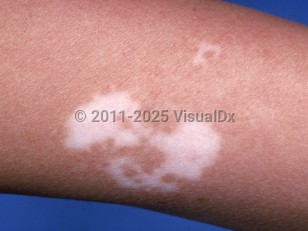Vitiligo in Infant/Neonate
See also in: External and Internal Eye,AnogenitalAlerts and Notices
Important News & Links
Synopsis

Vitiligo typically manifests as patterned white skin patches arising anywhere on the body but more commonly symmetrically in areas of frequent trauma, particularly on the face, upper chest, hands, elbows, knees, axillae, and perineum.
Due to the rare nature of the condition and lack of data, the etiology and progression of vitiligo are unknown. Varying hypotheses exist in the literature, including autoimmune, genetic, neural, autocytotoxic, or metabolic processes. It is thought that environmental factors might contribute to pathogenesis in genetically susceptible individuals. Genetic studies have shown candidate genes such as PTPN22. HLA seems to play a role in the pathogenesis of vitiligo. Studies have also revealed that XBP1, FOXP3, and TSLP can be associated with vitiligo.
Little is known as to why vitiligo presents at different ages and what factors might predispose individuals to develop lesions earlier on. It is thought that the immune attack might start in utero in genetically predisposed individuals and only presents clinically under the influence of other epidemiologic factors.
Congenital vitiligo with presentation at birth has been reported fewer than 10 times in the literature. One case reported a 2-month-old boy with vitiligo since birth born to 2 HIV-infected parents who were undergoing antiretroviral therapy for several years. Segmental vitiligo was reported in a 1-year-old boy with infantile generalized pustular psoriasis after 3 weeks of treatment with acitretin, with repigmentation once switched to secukinumab. Infantile vitiligo has been reported in a 5-month-old boy with immune dysregulation, polyendocrinopathy, enteropathy, X-linked (IPEX) with associated alopecia, and chronic diarrhea.
Vitiligo is linked to the co-occurrence of autoimmune diseases, including diabetes mellitus type 1, pernicious anemia, autoimmune thyroid disease, inflammatory bowel disease (Crohn disease, ulcerative colitis), Addison disease, alopecia areata, psoriasis, celiac disease, rheumatoid arthritis, systemic lupus erythematosus, Sjögren syndrome, and myasthenia gravis. A number of susceptibility loci seen in vitiligo are shared with these conditions.
Codes
L80 – Vitiligo
SNOMEDCT:
56727007 – Vitiligo
Look For
Subscription Required
Diagnostic Pearls
Subscription Required
Differential Diagnosis & Pitfalls

Subscription Required
Best Tests
Subscription Required
Management Pearls
Subscription Required
Therapy
Subscription Required
Drug Reaction Data
Subscription Required
References
Subscription Required
Last Updated:07/23/2025
 Patient Information for Vitiligo in Infant/Neonate
Patient Information for Vitiligo in Infant/Neonate- Improve treatment compliance
- Reduce after-hours questions
- Increase patient engagement and satisfaction
- Written in clear, easy-to-understand language. No confusing jargon.
- Available in English and Spanish
- Print out or email directly to your patient


